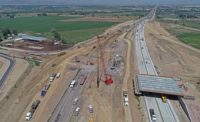UCHealth is on a tear.
Through both new construction and the acquisition of other medical facilities, the nonprofit health care organization is growing rapidly, from Greeley in northern Colorado to Colorado Springs.
Last August, UCHealth—which, despite its name, is a separate entity from the University of Colorado—opened the $190-million Longs Peak Hospital in Longmont, Colo. Early next year, it expects to open hospitals currently under construction in Greeley and Highlands Ranch, Colo.
In addition, on Sept. 1, 2017, UCHealth committed to more than $105 million in investments to connect with Steamboat Springs’ Yampa Valley Medical Center, now part of the UCHealth system. Accompanying the Longs Peak project was a buyout of the Longmont Clinic. Many of its 44 physicians are now affiliated with the new hospital. And effective April 1, UCHealth completed its acquisition of Pikes Peak Regional Hospital in Woodland Park, Colo.
Current construction for the nearly 1,800-bed network includes a 144,000-sq-ft, $110-million expansion of Memorial Hospital North in Colorado Springs; a 145,000-sq-ft, $105-million sports-medicine facility in Inverness, just south of Denver; and the 89,000-sq-ft, $60-million Cherry Creek Medical Center in central Denver. The facilities are expected to open at various times next year.
Last year, UCHealth also completed a 185,000-sq-ft, $99-million expansion at its Poudre Valley Hospital in Fort Collins, Colo.
The firm is investing more than $1 billion in new growth, says UCHealth spokesman Dan Weaver. And if the experience with Longs Peak Hospital in Longmont is an indication, the strategy is off to a good start.
On a recent March morning, Dan Robinson, Longs Peak Hospital president and CEO, noted that 41 of the hospital’s 51 beds were filled. Critical to the decision to build Longs Peak, he says, was the observation that in 2015 other UCHealth hospitals served more than 1,000 patients from the Longmont area.
The 220,000-sq-ft hospital took general contractor Haselden Construction just 14 months to build thanks to the extensive use of prefabrication, Robinson says. Among the prefabricated elements were steel structures and panels for HVAC, plumbing and other systems. The extensive prefab plan allowed building inspectors to review components on the ground. Throughout the project, Robinson estimates, prefabrication saved nearly 50,000 ladder-climbs.
Robinson says the entire project team—including Haselden, architects EYP Health and BSA LifeStructures and the many subcontractors—embraced UCHealth’s cultural ideal. That, he says, is the belief that “this is the place where, if you were to choose where to get health care for your loved one—if that’s your mom in the bed—you would choose us.”
Providing advanced care close to patients is the theme of UCHealth’s expansion, and the architectural components of its new facilities help support the company’s branding strategy. Especially prominent are arches that reflect UCHealth’s logo and which, Robinson says, represent the system’s “umbrella of care.”
Colorado Elements
Sean Menogan, UCHealth vice president for facilities, design and construction, says Colorado-themed elements include buff stone and brick as well as extensive glass. The new buildings are designed to appear similar, if not identical, to create a statewide look and feel.
Standardization is not only aesthetic but also structural, Menogan says. For example, all patient rooms in the hospitals in Longmont, Greeley and Highlands Ranch follow the same pattern. In addition to creating modularity for more efficient design and construction, the standardization has allowed UCHealth to obtain volume discounts on materials.
Another goal of the standardization, says Elizabeth Concordia, UCHealth president and CEO, is to place patients in familiar surroundings wherever they are within the UCHealth network.
“We want to make sure from a branding perspective that when patients come to any of our facilities, they have the expectation that we know them and they will get the same level of care or get the same experience,” Concordia says. “So, when they come in, no matter what the hospital or facility or whether they’re an inpatient or an outpatient, when they’re registered, it’s all similar. There’s a consistency.
“When you walk into any of our facilities, there’s not just a look and feel from a physical perspective but also the way we interact with you, in registering you, in discharging you, in explaining discharge instructions or presurgical instructions,” she says.
“They’re always doing exciting things. They’re doing new things.”
– Mike Ross, Senior Project Manager, Mortenson
Another contributor to standardization was an unusual meeting UCHealth held last fall with Haselden and three general contractors working on its other hospitals (M.A. Mortenson Co., Highlands Ranch; JE Dunn Construction, Greeley; GE Johnson Construction Co., Memorial Hospital North, Colorado Springs). More than 40 construction executives and project managers gathered in a room at Haselden’s headquarters in Centennial, Colo., to explore what had gone well in building Longs Peak Hospital in Longmont and to examine lessons learned.
Senior project manager Mike Ross of Mortenson calls the meeting “a pretty sound demonstration of always trying to improve. It definitely was really well received by us.”
Menogan notes UCHealth has built strong relationships with senior management at all the firms, which he describes as “top contractors.” For his part, Ross, of Mortenson—which has been working with UCHealth for nearly 10 years—says a strong rapport drives construction efforts with the medical organization.
“(UCHealth) really recognizes the value in having contractors that have long-standing, trusting relationships,” Ross says. “They transcend the individual projects. Nothing is transactional; nothing is one time. Everything is kind of an investment (where) this isn’t just one project, this is going to be the next five, six, eight years. That aligns really well with our approach.”
Ross describes UCHealth’s management as “really good, genuine people,” adding that “everybody we interact with is welcoming and inviting. They genuinely want to hear what we think about projects, issues, whatever the subject matter might be. And it’s always a good, open environment for that type of discussion. That puts the whole team in a really good place for having a good, effective collaboration and just getting really good results.
“They have a fair amount of marquee projects,” Ross continues. “Candidly, that’s something pretty cool. They’re always doing exciting things. They’re doing new things. They’re willing to embrace technology. And that’s really exciting for us as well and a lot more rewarding for team members, too.”
For example, UCHealth has a single, systemwide electronic records platform and operates what it calls a “virtual care center” at its main campus in Aurora, Colo. There, technicians keep an eye on monitors from intensive care units across the health system, and “e-sitters” use feeds from in-room robots and cameras to watch patients who might be at risk for falling.
For Menogan, who has overseen all the projects beginning with the concept stage, the process has been both rewarding and challenging. The rewards, he says, have come from seeing patients being treated in facilities he has helped build. The challenges, on the other hand, came principally from having to start planning the hospitals in Highlands Ranch and Greeley before Longs Peak was completed and before lessons could be fully digested.
That said, UCHealth’s projects continue apace. Not surprisingly, the progress is a point of pride for Concordia, who demands cost-effectiveness not only in construction but also in the delivery of health care.
Not surprisingly, Concordia is bullish on UCHealth’s future. With new hospitals popping up all along the Front Range, she confidently predicts, “We’re the organization to watch—you’ll see.”







Post a comment to this article
Report Abusive Comment